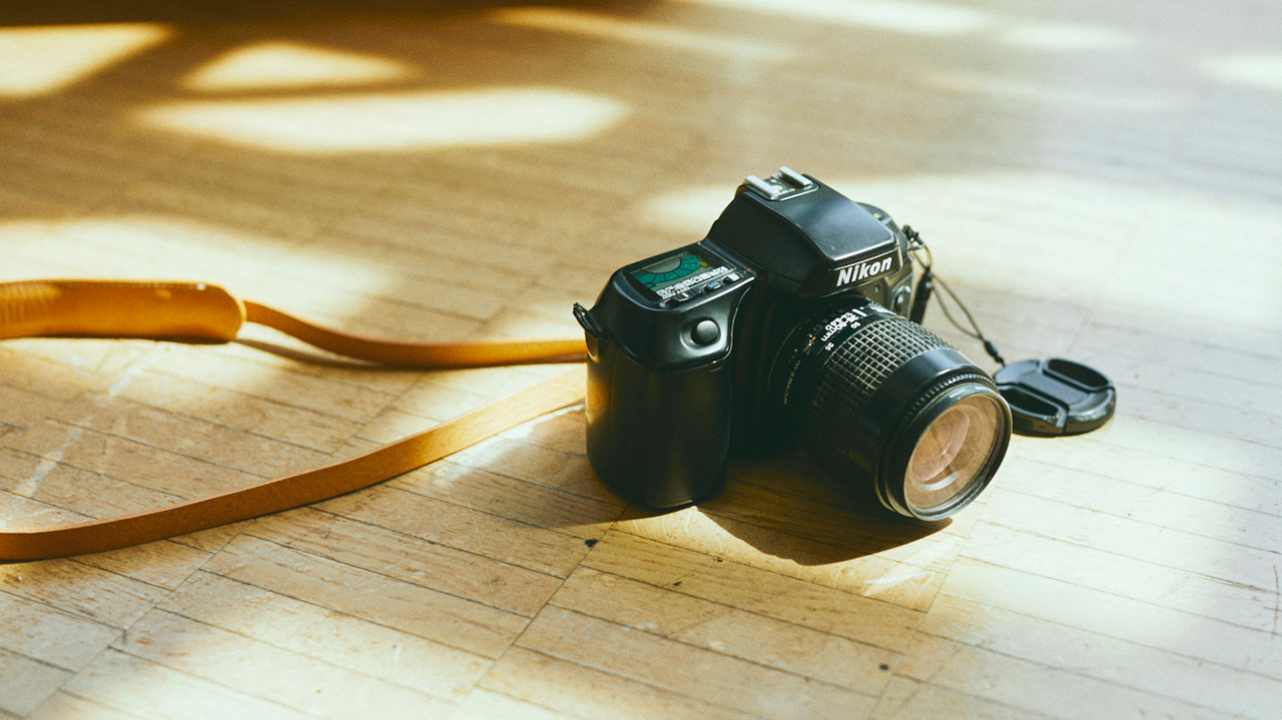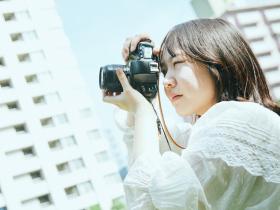What holding a photo exhibition taught me
Hikaru Yamamoto spent her student days with a camera in hand, hoping to convey through her photography transitory moments and the good qualities of the areas where she has lived. She has taken approximately 4,000 photographs with her film camera, carefully capturing scenes from ordinary daily life, including friends, family, and her route to school. In August 2022, she held her first photo exhibition in her hometown of Kyushu. Why did she decide to hold a photo exhibition and what did she learn? We take a closer look at Ms. Yamamoto’s student life and the sights she saw through her camera lens.


hikaru Yamamoto
Fourth-year student Department of Art Studies, Faculty of Letters
Hikaru Yamamoto started out majoring in graphic design at a university in Kyushu, but transferred to Meiji Gakuin University’s Department of Art Studies in 2022. She spent her days capturing transitory moments with her camera, including scenes along her commute to school on weekdays and what she saw at home or during walks at famous Tokyo landmarks on weekends. For fun, she reads the articles on Meiji Gakuin’s portal site, “Port Hepburn.” Her motto is “I want happiness that isn’t a drag.” She says it’s a phrase that expresses her desire for a life-sized happiness, one that won a prize in a campus competition.
Taking a chance with a transfer, to find something more suited to me
After graduating from high school, I started college at a university in Kyushu, majoring in graphic design. I’ve loved cameras since high school and liked the idea of obtaining skills I could apply to a job, so I was very interested in graphic design. I spent my days learning how to use Adobe products and other graphics tools, and photography techniques specific to photographing commercial products. It was fun, but I sometimes wondered if that kind of work was the right fit for me. Such feelings may have also been due to the COVID pandemic forcing me to spend more time at home, giving me more time for self-examination. Spurred on by that, I found myself gradually getting really into some Netflix shows. I particularly loved screenplays by Yuji Sakamoto, like Omameda Towako and Her Three Ex-Husbands, because they helped me realize the joy of reading a single work in different ways, such as according to the choice of words appearing in each piece or how the actors behave. This experience motivated me to transfer to the General Art Course in Meiji Gakuin University’s Department of Art Studies.
As a transfer student, I was able to start from my third year, but it took a lot of hard studying to catch up with my classmates. I ended up having to go back and forth between campuses, spending Mondays and Tuesdays in Yokohama, and Wednesday through Friday in Shirokane. It was a hard schedule, but the happiness of being able to learn what I wanted, and to do so while experiencing the excitement of living in the Kanto region for the first time, made each day fly by.
In Professor Hajime Hasegawa’s Second Year Exercises in Art and Media course in the Department of Art Studies, we students made three-minute self-introduction videos using the “digital storytelling” method to create a kind of self-narrative. I structured my story to be mainly about myself and my best friend, but the experience of taking an objective look at a video I’d shot was very new to me. In another class, where I had to produce and present in class a video about Royal Host, my favorite restaurant, I got experience with a broad range of tasks, including recruiting an editing team, negotiating with the restaurant for permission to film, and video editing. As someone who has always been interested in video production and photography, these classes were absolutely full of fun. The Department of Art Studies does a good job of matching what I want to learn with what I need to learn, and I am still having a fulfilling time, even in my fourth year.

The fun of waiting
I would like to touch on how I became interested in photography. I first started taking photographs in my first year of senior high school. I’d gone out with an old friend, who brought a disposable camera. I’d never used a film camera before, so it was somewhat shocking to me that it could actually take photos. Especially surprising was that we couldn’t immediately see the photos we took. But the excitement of waiting for the film to develop, the texture and warmth you can only get through film photography… These were very novel experiences, because I was only familiar with using smartphone cameras. At some point, I found myself hanging a film camera on the hook on the side of my study desk, in place of my school bag.
Taking photographs became part of my daily routine. Every time I got a “this is interesting” feeling during my daily life—while spending time with family or friends, while on the train on my way to school, while taking a walk—I would press the shutter button. I took photos that evoked positive emotions, like beautiful scenery or situations that looked fun, but I also tried to take photos that expressed negative emotions like frustration or sadness. For example, I photographed the time when my friend and I were reduced to tears when we didn’t pass a college entrance exam, and other times when we were unhappy. I believe that even a single photograph can contain an accumulation of memories that allows us to feel the emotions and growth occurring at that moment, sublimating it into a work of art.
So far, I’ve used around 140 rolls of 27-exposure film, meaning I’ve taken close to 4,000 photographs. I often receive kind words from people who look at my photos, such as, “You cheered me up,” or “Thank you for taking such beautiful photos,” giving me more opportunities to realize that my photos can be helpful. That is one reason why I decided to hold a photo exhibition.

The MG Action Challenge Grant realized my photo exhibition
For a time after deciding to hold a photo exhibition, I spent many days wavering between conflicting feelings. I wanted to use my photos to cheer on as many people as possible, but on the other hand, I also worried that no one would even show up. As I was worrying about such things, I read an article on Port Hepburn calling for applicants for the “Type B” MG Action Challenge Grant. This incentive program started in the 2022 academic year, the same year I enrolled, to partially support the establishment and proactive implementation of extracurricular activities by individuals and organizations not formally affiliated with Meiji Gakuin. I found myself frantically reading the requirements and filling out an application form. In the interviews that followed my application, I received many positive comments from the Student Affairs staff about the photos I had taken, which was a great encouragement.
I was selected for the grant, and in late July 2022 I started concrete preparations for using it to hold my exhibition. There was a lot to do, including settling on a concept, securing a venue, selecting and arranging the photographs I wanted to exhibit, and publicizing the event. It was a dizzying but fulfilling preparation period, but thankfully I had the help of two friends from my hometown in Kyushu who eagerly agreed to participate when I asked for their help. To decide how to arrange my photos, I started attending others’ exhibitions to see what they did and consider what kind of arrangement would work best for me.
I was able to make good use of something that I learned in my Art Management Theory course in the Department of Art Studies: “Remember that you’re making something for the people who will see it.” That helped me to realize that I was thinking in a self-centered manner, worried about things like what arrangement would make my photos look best, or how I should display my particular favorites, but I’d forgotten the obvious and important fact that an exhibition is only possible because there are people who will come to see it. Ultimately, I decided my focus should be “ease of viewing.” I arranged my photographs in various sizes, aiming to create an exhibit where the photographs are easy to see, are easy to understand, and easily catch the attention of visitors. I applied all my attention to preparing for the exhibition, so we didn’t really run into any major problems, but I was still worried about how to get people to attend. The more effort I put into my preparations, the more I worried whether I would be able to pull it off, but that became a driving force allowing me to accomplish everything I set my mind to, such as implementing my friends’ suggestions to set up photo spots and making full use of Instagram and word of mouth for publicity. So this preparatory period taught me an important lesson: worry can push me forward, I just need to give things a try.

Why I’m glad I became a photographer
I held my photo exhibition on August 23 and 24, 2022 in Fukuoka’s Chuo Ward. On the first day, the venue was crowded with visitors from the time we opened. The exhibition’s theme was “Local Goodness.” I settled on that theme because I wanted those viewing my photos to feel the “local goodness” of the places I’d lived, like Nagasaki where I grew up, and Fukuoka and Tokyo where I’d studied. I heard comments like “That’s me!” and “Oh, I remember that!” and “I really want to visit Nagasaki.” The kind words I heard from my guests and friends made me truly thankful I’d picked up photography.
As a result of my photo exhibition, I heard comments from my friends in the Department, like “You held a photo exhibition? That sounds like so much fun!” That led to them inviting me to participate in their own projects, which in turn helped me make new friends.

I want to continue on with a camera at my side
We’re often told, “If you have any problems, please consult with the University,” and thanks to my experience holding a photo exhibition, I now understand that sentiment better. Through reading a University announcement on Port Hepburn, then applying for and receiving guidance for a grant, I found ways to resolve things I was concerned about and I realized one of my dreams. I can now state with confidence that there are people at Meiji Gakuin who will encourage me to do what I want to do.
The experience of holding a photo exhibition not only allowed me to reconfirm the joy and wonder of photography, it also allowed me to experience the fun and reward of planning and realizing a project on my own. This experience provided me with a new sense of value as I work toward a future career in the video industry. It showed me how by doing what I want to do, I can make others happy. I will always cherish this simple yet precious and universal value as I head into the future, with a camera at my side.

